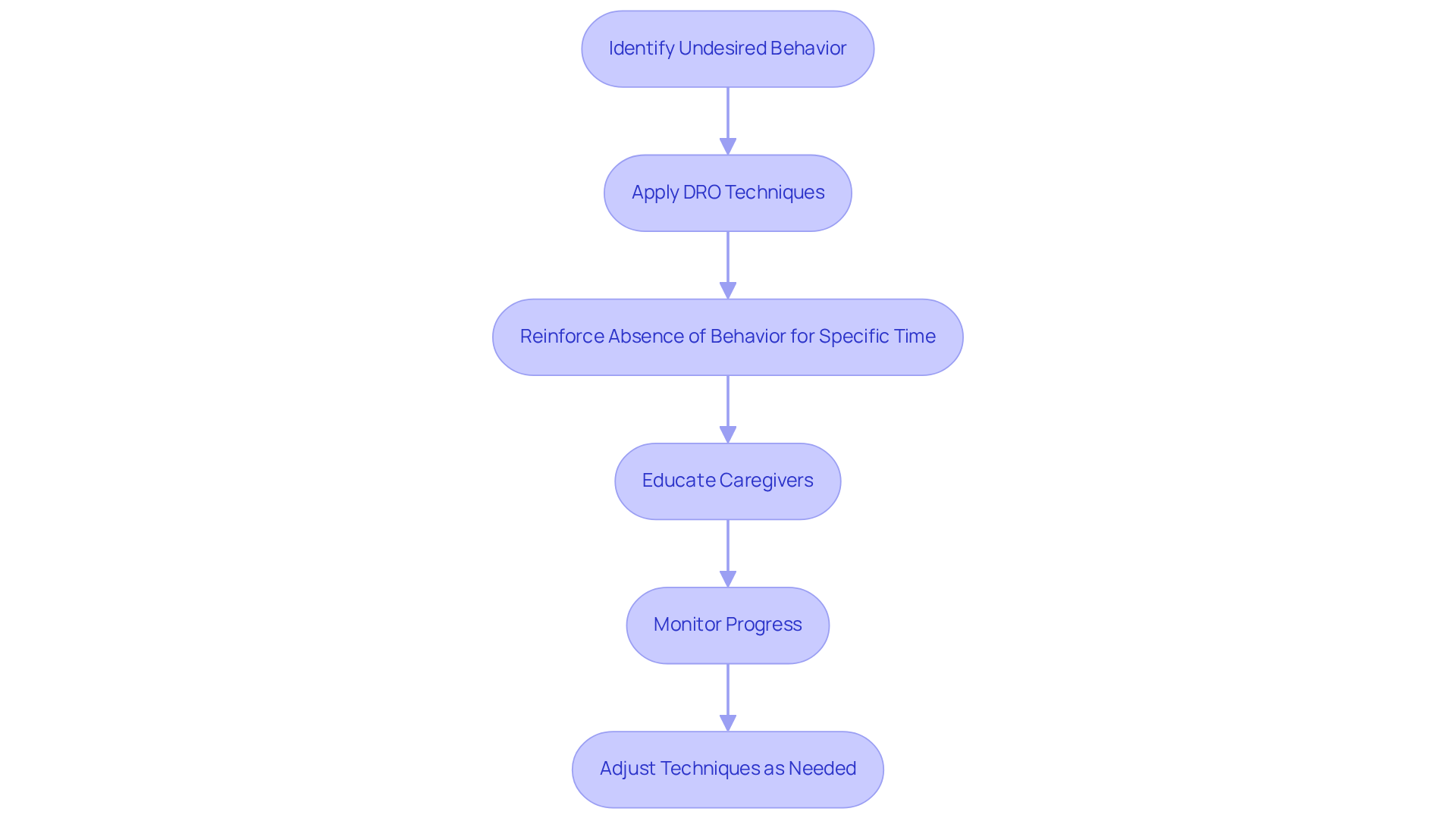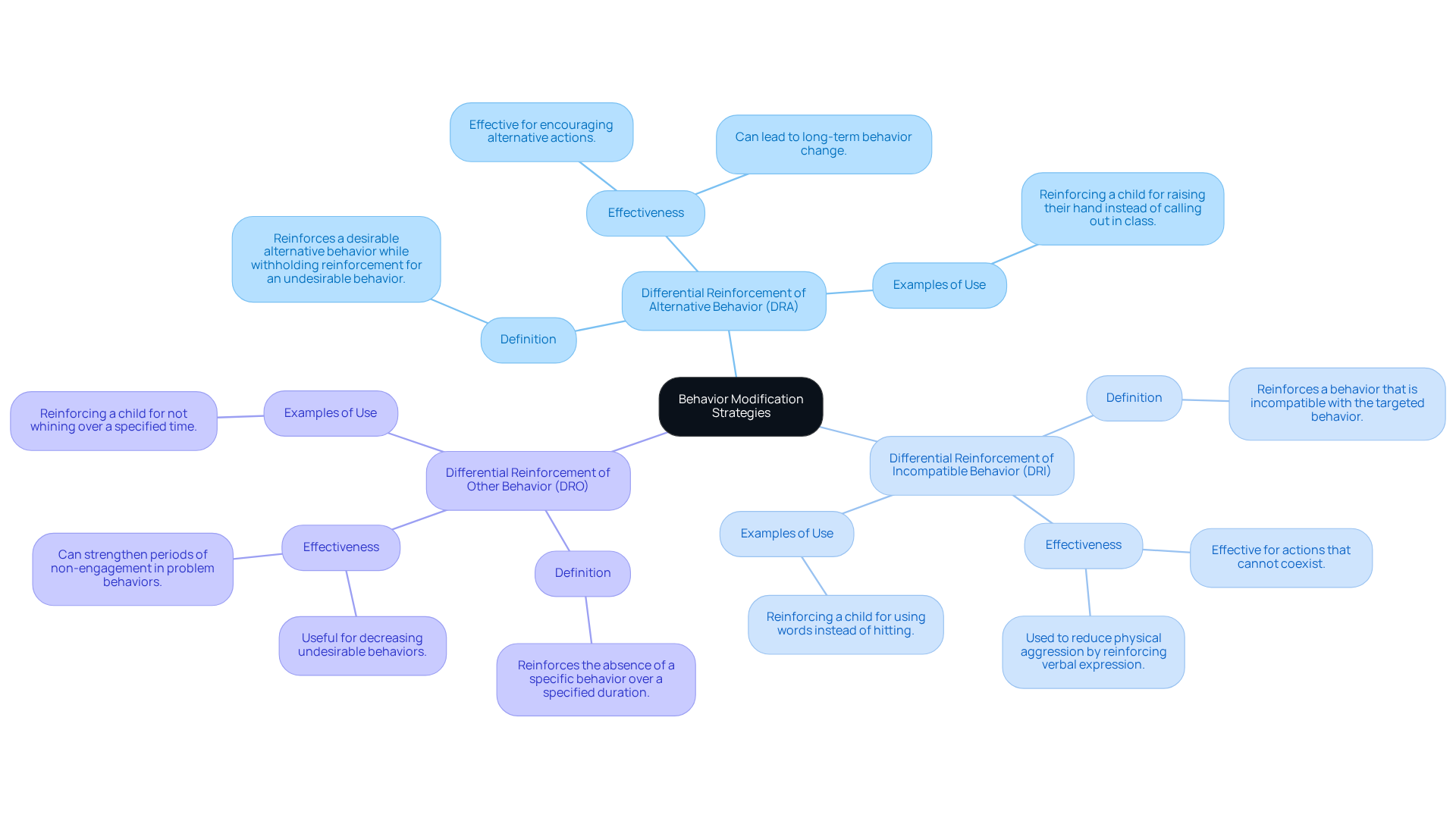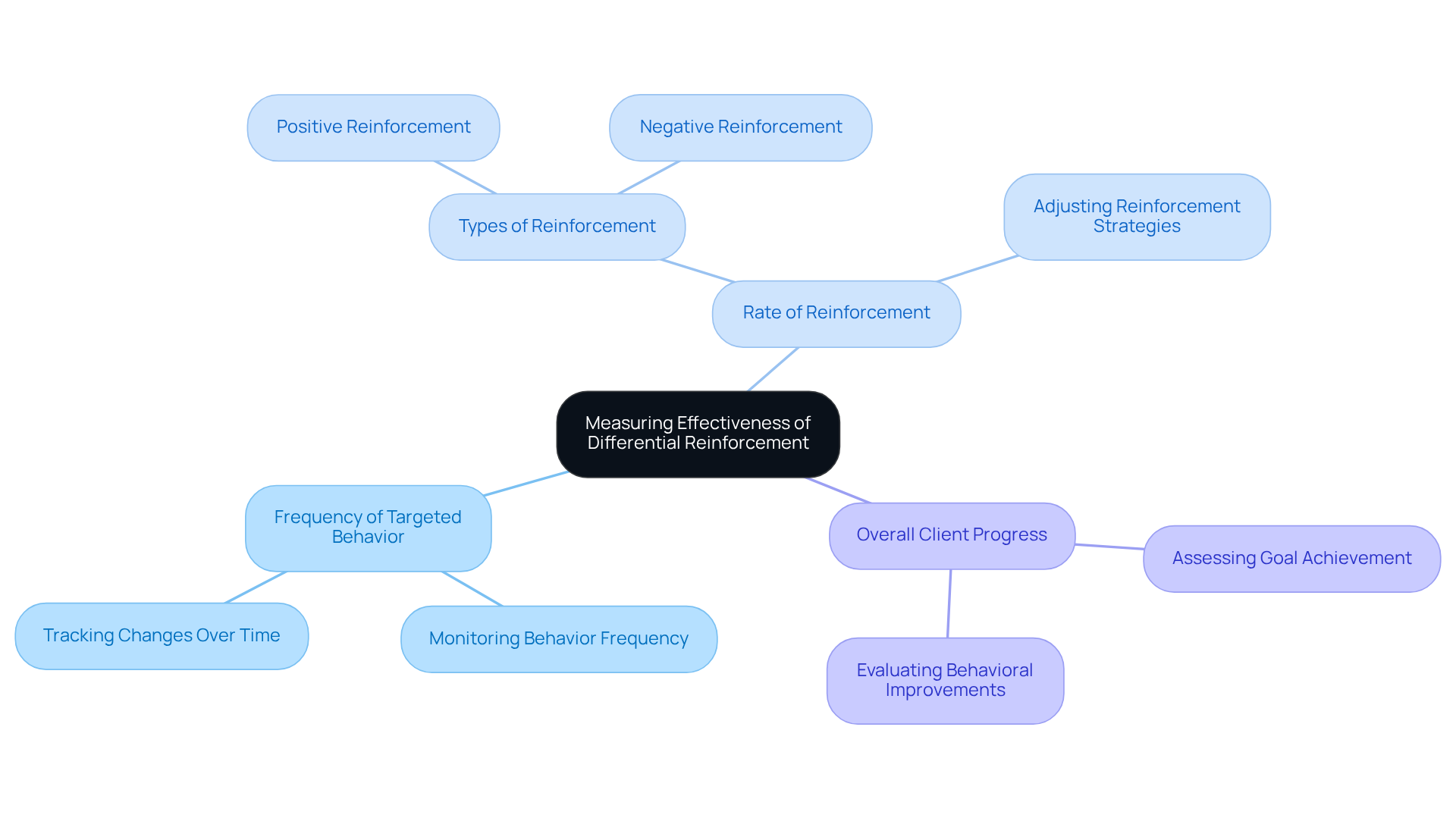October 25, 2025

The article provides a comprehensive overview of differential reinforcement strategies utilized in Applied Behavior Analysis (ABA) to effectively modify behavior. It highlights various techniques, including:
Through practical applications, the article demonstrates their effectiveness in promoting positive behaviors while simultaneously reducing undesirable ones in both educational and home settings.
Differential reinforcement strategies have emerged as essential tools in behavior management, particularly within the realm of Applied Behavior Analysis (ABA). By focusing on reinforcing desirable behaviors while diminishing unwanted ones, practitioners can create more positive and engaging environments for individuals, especially children with autism. This article delves into ten compelling examples of differential reinforcement, offering insights into their practical applications and benefits.
However, with various techniques available, how can behavior analysts determine the most effective approach for specific situations? The exploration of these strategies not only highlights their significance but also addresses the challenges practitioners face in implementing them effectively.
As we delve deeper, consider the current challenges you may face in behavior management. How can these strategies transform your practice and enhance the outcomes for those you serve? This inquiry not only underscores the importance of differential reinforcement but also invites you to reflect on the potential improvements in your approach.
In today's competitive landscape, the demand for Board Certified Analysts (BCBAs) is at an all-time high. Hire ABA serves as an essential resource for these professionals, providing differential reinforcement examples and specializing in differential reinforcement techniques. Our personalized resume assessments evaluate your experience and career goals, ensuring we match you with the best roles available.
By utilizing advanced job fit scoring, we identify opportunities that align with your skills, preferences, and desired locations. This effective job matching procedure not only aids job seekers but also assists employers in locating candidates skilled in successful behavioral techniques. Are you facing challenges in hiring qualified BCBAs? Let Hire ABA simplify your recruitment process.
Ultimately, our goal is to improve the quality of care in ABA environments. Trust in Hire ABA to connect you with the right talent—take the first step towards enhancing your team today.

Differential reinforcement examples, such as Differential Reinforcement of Alternative Actions (DRA), stand as a pivotal strategy in behavior management, effectively promoting desirable actions as substitutes for unwanted behaviors. Consider a scenario where a child frequently shouts for attention; a Board Certified Behavior Analyst (BCBA) might provide differential reinforcement examples by encouraging the child to raise their hand instead, reinforcing this positive behavior. This method not only cultivates constructive conduct but also diminishes the frequency of undesirable behaviors, thereby nurturing a more supportive educational environment.
Before the implementation of DRA, it is imperative to conduct a functional behavior assessment. This evaluation serves to identify specific behaviors that warrant attention, ensuring that interventions are tailored to meet individual needs. Research underscores that differential reinforcement examples can significantly bolster communication skills and emotional regulation, particularly among children with autism. In educational settings, effective applications of differential reinforcement examples demonstrate that when educators consistently reinforce appropriate behaviors, students are more likely to engage positively. For instance, in a classroom where students are provided with differential reinforcement examples for raising their hands, the instances of shouting for attention decrease dramatically.
Recent studies illuminate the effectiveness of DRA within Applied Behavior Analysis (ABA) therapy, emphasizing that the quality and timeliness of rewards are crucial in modifying behaviors. Both DRA and differential reinforcement examples, such as Differential Reinforcement of Other Actions (DRO), have proven successful in mitigating problematic behaviors while enhancing academic engagement. By providing immediate, high-quality differential reinforcement examples for appropriate actions while delaying or reducing rewards for unwanted behaviors, practitioners can achieve clinically meaningful improvements in conduct. This approach not only fosters a positive atmosphere but also aligns with best practices in behavior management, establishing DRA as an indispensable resource for BCBAs and educators alike. Furthermore, understanding the matching law—illustrating how response rates correspond with reinforcement rates—can further refine the application of DRA techniques. However, it is essential to recognize that DRA may face limitations when implemented without extinction, a factor that must be considered in intervention planning.

Differential Reinforcement of Incompatible Actions (DRI) serves as a powerful strategy in Applied Behavior Analysis (ABA), effectively promoting actions that oppose undesirable behaviors. For instance, when a child frequently runs in the classroom, a Board Certified Analyst (BCBA) may reinforce the child for sitting quietly. This approach is effective because the two behaviors cannot occur simultaneously, thereby reducing the unwanted behavior while encouraging a more appropriate alternative. DRI, along with differential reinforcement examples such as Differential Reinforcement of Alternative Behavior (DRA) and Differential Reinforcement of Other Behavior (DRO), can be tailored to address a variety of behavioral challenges, establishing DRI as an essential tool in the field.
Research underscores the significant impact of DRI on classroom management. One study revealed that educators experienced a remarkable 70% reduction in disruptive behaviors when consistently implementing DRI strategies. This method not only enhances compliance but also cultivates a positive learning atmosphere.
Case studies further exemplify the efficacy of differential reinforcement examples in demonstrating effective practices. In a classroom scenario, a child displaying physical aggression was rewarded for participating in non-aggressive activities, such as engaging with a puzzle. This intervention resulted in a notable decrease in aggressive behaviors, demonstrating DRI's capacity to replace harmful actions with constructive ones.
Moreover, statistics indicate that DRI can improve classroom dynamics. Teachers employing DRI techniques have reported enhanced student focus and engagement, contributing to improved academic outcomes. For instance, a survey found that 85% of educators considered DRI beneficial for managing student behavior, highlighting its role in fostering a supportive educational environment. As Timothy R Vollmer aptly stated, "Differential support is a fundamental principle of conduct analysis that has led to the creation of a set of procedures used as intervention for problematic actions."
In conclusion, DRI is a vital instrument in Applied Behavior Analysis (ABA), effectively reducing problematic behaviors while reinforcing positive alternatives. By concentrating on incompatible actions, educators can establish a structured environment that nurtures student growth and well-being. Ultimately, the goal of differential reinforcement is to enhance the individual's quality of life by mitigating challenging behaviors, ensuring that ethical considerations are prioritized in all interventions.

Differential reinforcement examples, particularly Differential Reinforcement of Other Actions (DRO), stand out as a powerful approach in behavioral analysis, emphasizing the rewarding of the absence of a specific unwanted action over a designated time frame. For example, when a child frequently interrupts during class, a Board Certified Behavior Analyst (BCBA) may utilize differential reinforcement examples that reward the child for refraining from interrupting for five minutes. This method not only motivates the child to avoid undesired behaviors but also fosters a more positive classroom atmosphere.
Research underscores the effectiveness of differential reinforcement examples, revealing that when they are executed properly, they can lead to significant behavioral improvements. Studies indicate that approximately 90% of children exhibit remarkable progress when caregivers are actively involved in the reinforcement process. The typical duration for applying DRO techniques is around 4.29 minutes, making it an accessible strategy for educators.
By reinforcing intervals of appropriate behavior, educators can cultivate a structured environment that enhances engagement and minimizes disruptions. Furthermore, educating caregivers is crucial for the successful implementation of DRO techniques, equipping them with the necessary knowledge to support their children's behavioral goals. Clear communication regarding support expectations is vital, as it significantly boosts the efficacy of DRO in managing classroom behavior.
Moreover, DRO can be customized through fixed or variable schedules, providing flexibility in its application. Ethical considerations are paramount, ensuring that interventions uphold individual rights while prioritizing positive reinforcement.

Differential Reinforcement of Low Rates of Conduct (DRL) is a strategic approach aimed at reducing the frequency of undesirable behaviors rather than eliminating them entirely. Consider the scenario of a child who frequently talks out of turn; a Board Certified Behavior Analyst (BCBA) may reinforce the child for only speaking out once during a class period. This method not only acknowledges the child's intrinsic need to communicate but also facilitates a gradual decrease in the occurrence of the unwanted behavior.
Such an approach is essential in behavior management, as it recognizes that complete eradication of behavior may not be feasible or beneficial. Instead, DRL fosters an environment where positive communication is encouraged while simultaneously addressing behavioral concerns. As you reflect on your current strategies for managing behavior, consider how incorporating DRL could enhance your effectiveness.
In summary, employing differential reinforcement examples like Differential Reinforcement of Low Rates of Conduct offers a balanced solution that respects the child's need for expression while promoting more appropriate behavioral patterns.

Differential Reinforcement of High Rates of Actions (DRH) stands as a compelling strategy that reinforces increased frequencies of desired actions. In a classroom environment, for instance, a Board Certified Behavior Analyst (BCBA) may motivate a child to engage in discussions by providing positive feedback for every contribution made during the session. This method not only boosts student engagement but also cultivates self-confidence as children become aware of their capacity to contribute meaningfully.
Research indicates that DRH can significantly elevate participation rates; while specific figures are not provided, studies reveal that students receiving encouragement for heightened engagement often demonstrate notable improvements in classroom contributions. This strategy proves particularly effective in promoting preferred actions, aligning seamlessly with the natural learning process and inspiring students to participate more frequently.
BCBAs stress the necessity of tailoring reward strategies to meet individual needs. One BCBA stated, "By prioritizing the learner’s preferences and choices when selecting target actions for reinforcement, we can create a more motivating environment that encourages participation." This underscores the importance of customizing approaches to enhance effectiveness.
Successful implementations of differential reinforcement examples can be seen in classroom scenarios where teachers establish specific criteria for participation, such as requiring students to ask a minimum number of questions during discussions. As students fulfill these criteria, they receive praise or tangible rewards, thereby reinforcing their active involvement.
In conclusion, DRH not only promotes student involvement but also nurtures a positive learning environment where preferred actions are consistently recognized and rewarded.

When selecting among Differential Reinforcement of Alternative Actions (DRA), Differential Reinforcement of Incompatible Actions (DRI), and Differential Reinforcement of Other Actions (DRO), Board Certified Behavior Analysts (BCBAs) must evaluate the specific actions they intend to alter.
Did you know that understanding these distinctions can significantly enhance behavior modification outcomes?
Each approach has its distinct uses, and grasping these distinctions is essential for effective modification of actions.
Research suggests that differential reinforcement examples, such as implementing DRA and DRI, can result in substantial enhancements in outcomes for modifying actions, with studies demonstrating that these approaches can effectively decrease issue behaviors when applied thoughtfully.
As noted by All Star ABA, 'For differential support to function effectively, it must be executed consistently and accurately.' Therefore, BCBAs must thoroughly evaluate the unique requirements of their clients and the particular actions they aim to address to select the most efficient strategy.
Are you ready to optimize your approach to behavior modification?

Differential reinforcement examples are increasingly recognized for their versatility and effectiveness across various environments, particularly in educational and home settings. With the growing demand for Board Certified Behavior Analysts (BCBAs), understanding the application of these techniques is essential.
In educational environments, BCBAs frequently implement differential reinforcement examples such as:
In home settings, Differential Reinforcement of Other actions (DRO) can be effectively employed. Consider a scenario where a parent reinforces a child for remaining calm and refraining from tantrums for a specified duration, such as five minutes. This approach cultivates the absence of unwanted behaviors while promoting a peaceful home environment.
Statistics reveal that the use of differential incentives in schools has led to significant improvements in student conduct. Research indicates that organized reinforcement strategies can reduce disruptive behaviors by as much as 70%. This statistic underscores the importance of these methods in fostering positive learning experiences.
Moreover, practical applications of differential reinforcement examples, such as:
Overall, the tailored implementation of differential reinforcement techniques, whether in schools or homes, highlights their critical role in improving behavioral outcomes for individuals with autism and other developmental disabilities. By concentrating on positive behaviors and systematically reinforcing them, practitioners can create supportive environments conducive to growth and learning. Ethical considerations are paramount; interventions must respect the rights and well-being of individuals. Continuous data collection is vital for evaluating the effectiveness of these approaches, allowing for necessary adjustments to optimize results.
![]()
Applying differential reinforcement examples often encounters significant challenges, particularly client opposition and inconsistent rewards. Notably, research indicates that approximately 66% of children referred for ABA therapy initiate treatment and remain engaged for at least 12 months. This statistic underscores the necessity of effective strategies to maintain client participation.
To effectively address resistance, Board Certified Behavior Analysts (BCBAs) must:
Engaging caregivers in the therapeutic process is essential, as their involvement can greatly enhance both engagement and adherence to treatment plans. Ongoing training and support for therapists and caregivers ensure alignment in approaches, fostering a collaborative environment that promotes successful outcomes.
By actively listening to clients and adapting strategies based on their feedback, BCBAs can further mitigate resistance and enhance the effectiveness of differential reinforcement examples.

To effectively assess the impact of differential reinforcement examples, Board Certified Behavior Analysts (BCBAs) must diligently monitor key indicators. These include:
Are you currently leveraging data collection tools? Regular assessments provide invaluable insights into the success of your implemented strategies. By doing so, you can identify areas needing adjustment, ultimately optimizing outcomes for your clients. The reliability of these methods cannot be overstated; they are essential for ensuring that interventions are both effective and responsive to client needs.

Differential reinforcement techniques serve as essential tools in Applied Behavior Analysis (ABA), providing a structured approach to encourage positive behaviors while simultaneously reducing undesirable actions. Understanding and effectively implementing strategies such as:
enables practitioners to create supportive environments that foster growth and learning.
Key insights discussed throughout the article highlight the importance of:
Real-world applications demonstrate how these techniques can significantly improve classroom dynamics and enhance communication skills, particularly among children with autism. Furthermore, the engagement of caregivers and the collection of data to measure the effectiveness of these strategies were emphasized, ensuring that interventions remain responsive and effective.
In conclusion, the successful application of differential reinforcement strategies is crucial for fostering positive behavioral outcomes across various settings. By prioritizing ethical considerations and continuously refining approaches based on feedback and data, Board Certified Behavior Analysts (BCBAs) can make a meaningful impact on the lives of the individuals they support. Embracing these techniques not only enhances the quality of care but also empowers practitioners to optimize their interventions, ultimately leading to improved behavioral success and well-being for clients.
What is Hire ABA and how does it assist BCBAs?
Hire ABA is a resource for Board Certified Behavior Analysts (BCBAs) that provides job matching services, personalized resume assessments, and identifies job opportunities aligned with skills and preferences to improve the recruitment process for employers.
What is Differential Reinforcement of Alternative Behavior (DRA)?
DRA is a behavior management strategy that encourages desirable actions as substitutes for unwanted behaviors. For example, a BCBA might reinforce a child for raising their hand instead of shouting for attention.
Why is a functional behavior assessment important before implementing DRA?
A functional behavior assessment identifies specific behaviors that need attention, ensuring that interventions are customized to meet individual needs effectively.
How does DRA benefit children with autism?
DRA has been shown to significantly improve communication skills and emotional regulation in children with autism by reinforcing appropriate behaviors and reducing undesirable ones.
What are the key components of effective DRA implementation?
Effective DRA implementation relies on the quality and timeliness of reinforcement, ensuring immediate rewards for appropriate behaviors while delaying or reducing rewards for unwanted behaviors.
What is Differential Reinforcement of Incompatible Behavior (DRI)?
DRI is a strategy that promotes behaviors that cannot occur simultaneously with undesirable behaviors. For instance, reinforcing a child for sitting quietly instead of running in the classroom.
What impact does DRI have on classroom management?
Research indicates that consistent implementation of DRI strategies can lead to significant reductions in disruptive behaviors, enhancing compliance and creating a positive learning environment.
Can you provide an example of DRI in action?
An example of DRI is rewarding a child for engaging in non-aggressive activities, like puzzles, which leads to a decrease in aggressive behaviors.
How does DRI contribute to improved academic outcomes?
DRI techniques have been reported to enhance student focus and engagement, which contributes to better academic performance and a supportive educational atmosphere.
What is the ultimate goal of differential reinforcement techniques like DRA and DRI?
The ultimate goal is to enhance the individual's quality of life by reducing challenging behaviors and promoting positive alternatives while ensuring ethical considerations are prioritized in interventions.
Our expert recruitment strategies and AI-driven sourcing ensure that you receive top-notch candidates quickly, without compromising on quality. Whether you’re looking for BCBAs, Clinical Directors, or RBTs, we’ve got you covered.